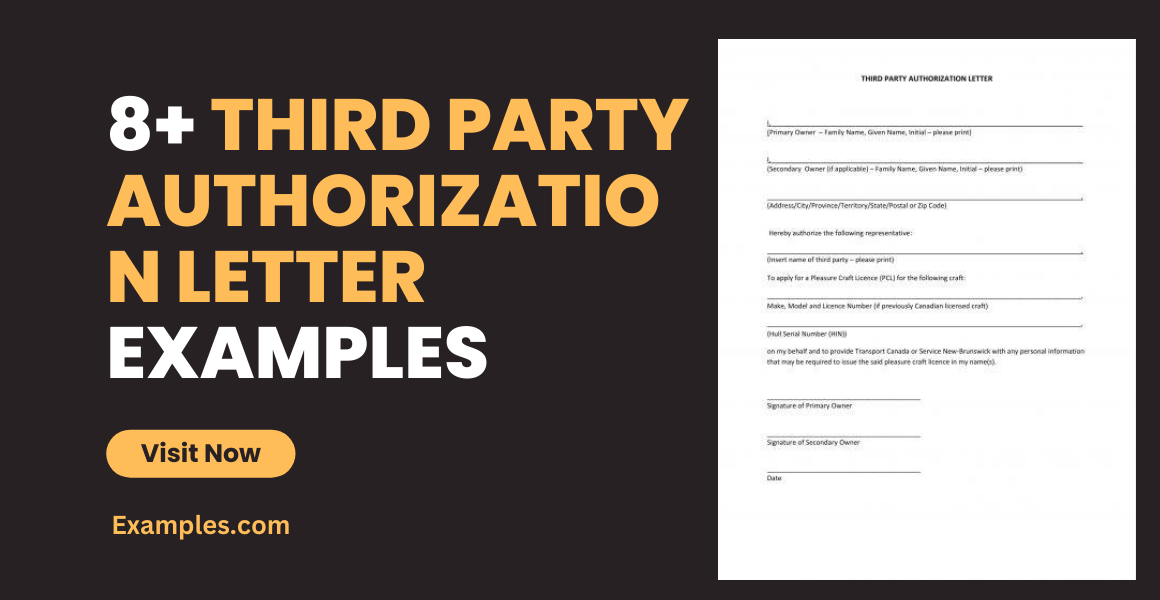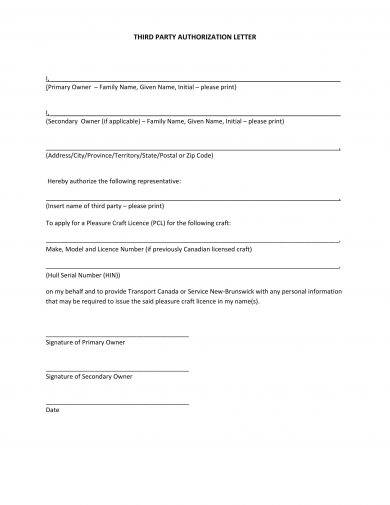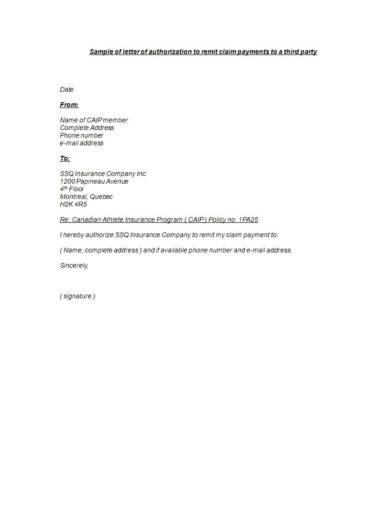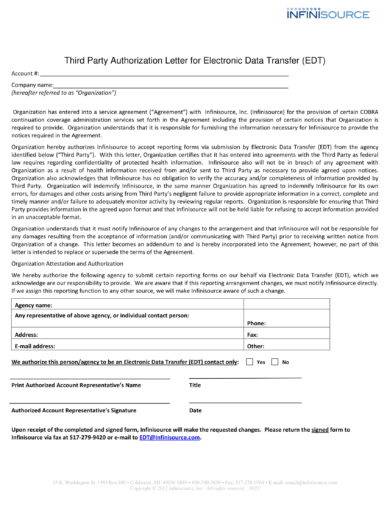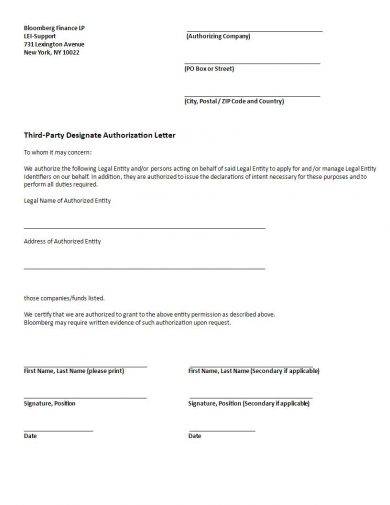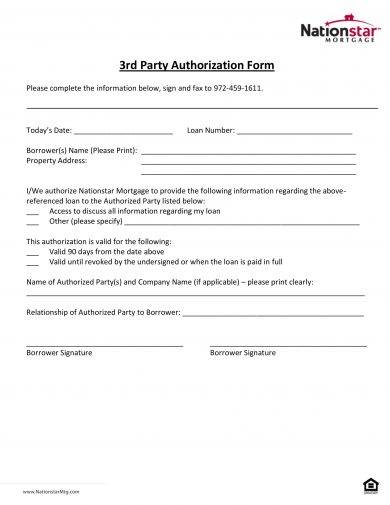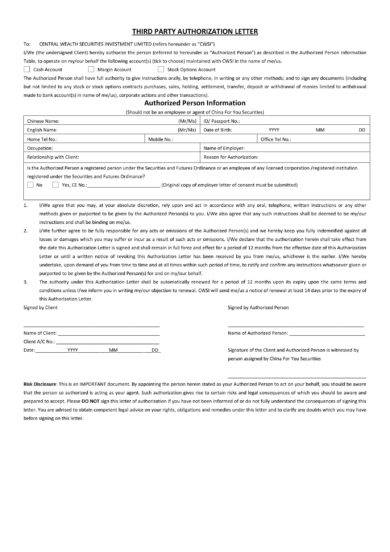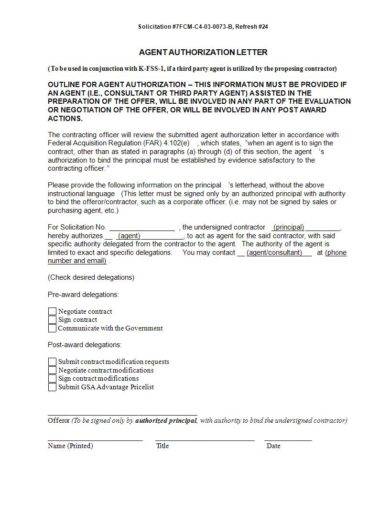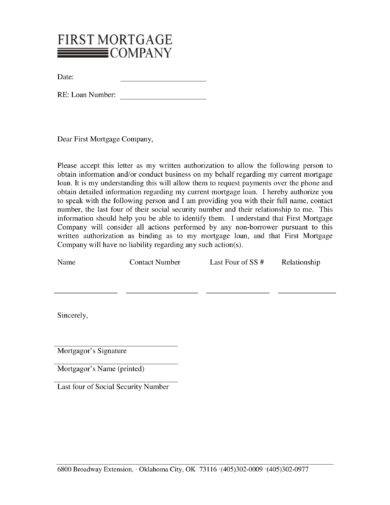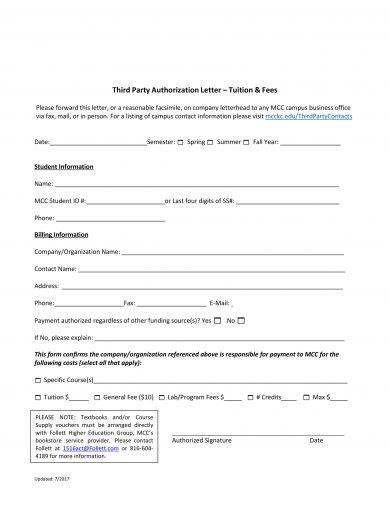8+ Third Party Authorization Letter Examples to Download
When you conduct business with companies and/or organizations, you may be required to execute the transaction with a middleman or an agency that will do the business in behalf of you. The middleman or third-party agency will help facilitate the business transactions for you. You may also see child care authorization letter examples.

However, this not the only scenario where a third party will be useful; you can also be the third party in another transaction. In a chain of command, you will need to have the right authorization from your higher authority in order to execute an action. You may also like notice letter examples.
In the cases given above, you will need a third party authorization letter in order to perform an action or you will need to provide a party authorization letter to your middleman or third-party agency, organization, firm, etc.
Without the third party authorization letter, a specific or certain action cannot be carried out, the formal letter will serve as the right permission needed to continue on with the process. A third party authorization letter is mainly used in business environment, for legal matters, for clearance, and so on.
Third Party Authorization Letter Format Example
Authorization Letter Example to Remit Claim payments to a Third Party
Electronic Data Transfer Third Party Authorization Letter Example
Concepts to Consider When Evaluating Third Party Relationships
It is quite often for companies and organizations to utilize third-party entities to achieve their strategic objectives; that way they are increasing the efficiency and cost savings by shifting non-core or specialized functions to more experienced providers. As the need for outsourcing grows, so does the access to sensitive data and processes these parties have. You may also see email cover letter examples.
With this rapid increase in mind, you need to make sure that your third-party controls and monitoring strategies also evolve, not only to make sure that the third party performs effectively and complies to your simple agreement, but also to secure proprietary information and prevent your company from getting caught in negative publicity. Here are some of the concepts you need to consider when evaluating your third-party relationships:
1. Know and understand your third-party relationship
Any business arrangement between an organization and another entity, by contract or otherwise, is called a third-party relationship. Companies that you have contracts and business transactions with such as vendors, suppliers, distributors and contractors are recognized or considered as third parties. However, even long-term undocumented general agreements with manufacturers, brokers, agents, resellers, etc., also qualify as third parties.
And you may not know this but some of your third parties may have been utilizing third parties themselves and can cause additional challenges in contract management and oversight. You should be able to obtain an understanding if your third parties will be allowed to enter subcontracts for their other obligations, and if your basic agreement terms and conditions should discuss them as part of your third-party relationship management.
2. Ensure adequate insurance coverage
When you first entered into an agreement with a third party, the coverage for the insurance may change overtime.
As the technology, delivery locations, or manufacturing locations change after the contract has been signed, the adequacy of the previous insurance may not be enough on the present. Third-party relationships normally have a specified level of insurance coverage as part of the requirements, but as mentioned above, some things may change and the needs for insurance coverage may also change. You may also see business proposal letter examples.
Before your company is faced with additional risk, it is better to maintain proper coverage and account for unexpected event or situations.
3. Review and make sure contracts align with new laws
You need your contracts to be updated in order to reflect the latest regulations for data security and privacy. As years passed from your initial agreement, some clauses or inclusions may need to be updated in order to clearly define the responsibilities between both parties. You have to make sure you have a clear seclusion of responsibility about data protection and a clear plan in case of a data breach. You may also like business reference letter examples.
As companies continue to expand internationally, compliance to international laws have been given more attention due to concerns about foreign third parties’ compliance measures. In addition, some countries have passed new laws that may affect your company as well as your third-party relationships, better to adhere to these new laws so that future legal repercussions can be avoided. You may also check out application letter examples & samples.
4. Develop and implement a third-party risk management process
The main goal of a third-party risk management process is to determine the highest risk third-party relationships that you have and put proper actions to mitigate these risks into a tolerable level. A flexible framework should be utilized so that a holistic approach in assessing third-party relationships can be taken. In addition, it can also help supply or find supplies to the evolving needs of your company or organization. You might be interested in complaint letter examples & samples.
Developing as well as implementing third-party risk assessment starts with making use of a cross-functional team and clearly determining the roles and responsibilities in performing the assessment.
The risk categories to be assessed as well as the levels as to which is deemed critical should be done next. There are other ways and tools you can use to help you identify these risks; it’s a matter of finding what works best for your company and the nature of the relationship you have with the third-party entity. You may also see simple resignation letter examples.
5. Help manage risk expectations with audits
Another way of managing risk expectations is with the use of audits. A third-party agreement should have a right-to-audit clause that will allow you to assess if the third party is complying with the terms and conditions of your agreement. You should perform a periodic third-party audit to make sure that the contracts you have made are being complied; however, it still depends on the significance of the general contract to your company.
In the same sense, in the event of opening a new agreement and closing of the old ones, an audit can help you see how well and how effective the third party is in doing its responsibilities.
Third-Party Designate Authorization Letter Example
Third Party Authorization Form Example
Third Party Authorization Letter Example
Tips in Writing a Third Party Authorization Letter
In order to make sure that a permission to perform a specific task is granted, the simple letter should specifically and clearly state the stature and limitations of the responsibilities and accessing powers of a third-party entity. The third party authorization letter should be written clearly in order to convey the exact and right information to the receiving end. Here are some tips you can use as guide when writing a third party authorization letter:
- Start the letter by following a professional or business letter format. You still have to include a letterhead, if available, the return and inside address, the date, the proper salutation as well as the appropriate closing.
- You have to clearly state the name of the address of the company or individual who will be giving you or to whom you give the authority to. The identification of the third party should be clearly stated so that there confusions and miscommunication can be avoided. You may also see offer letter examples.
- Make sure to use a formal and appropriate tone in your letter. As you may know, this letter is used mainly for professional or business-related transactions. Therefore, keeping the letter as professional and as clear possible should be your priority.
- Be straight to the point. Avoid discussing or mentioning other details that do not directly relate to the topic or main purpose as to why you are writing the letter. Make sure that you clearly distinguished the person or company giving authority from the person or company that is given the authority as a third party. You may also like thank-you letter examples.
- Make sure that you clearly state and explain the obligations and responsibilities that is being authorized. The contact information of the third party should be included in the letter so that the person or company can be easily contacted in case questions or issues arise. You may also check out incident report letter examples.
- There is no need in writing an eloquent and complex third party authorization letter. It should be direct and straightforward, so long as the accurate definition of the roles and responsibilities and the accurate name and contact information of the third party is stated it should be fine. You might be interested in recommendation letter examples & samples.
Third Party Agent Authorization Letter Example
Third Party Mortgage Authorization Letter Example
Third Party Payment Authorization Letter Example
Conclusion
A third party authorization letter is an important document that will allow other people, organization, company, or firm to have access to some sensitive information about you and/or your business. Depending on the tasks or responsibilities you and the third-party entity have agreed on, the third party will have to function according to what has been stated in the official letter and nothing more.
For example, when you allow an investment firm to have access on your bank statements because you are applying for a loan or investment plan, you will need to have a third party authorization that is duly certified as legal and true. Only then will the investment firm be able to examine your bank statements.
In conclusions, a third party authorization letter is the only one of the few letters that has the power to give other people gain access to whatever scope may be stated. It can help you achieve the smart goals you have planned more efficiently, but it can also have its risks and disadvantages. Therefore, before you sign an authorization letter allowing third party to have access to your information, be it personal or work-related, you need to make sure that an agreement is made and that your terms and conditions are duly followed.
Otherwise, it can cause negative publicity and even damage your reputation as well as your business. We hope that this guide has helped you and that you find use for the third party authorization letter examples given above.


